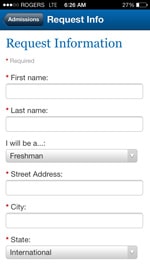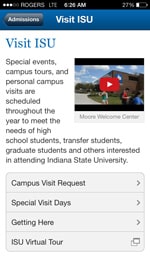Part 2: Mobile marketing for educators: Driving engagement and prospect conversion
Last week, we underscored the importance of mobile marketing (i.e., marketing that engages students on their phones – especially their smartphones), citing statistics like these, from the 2013 E-Expectations Report:
- 78% of students had regular access to a mobile device;
- 43% reported using their mobile devices for all their web browsing;
- 68% said they had viewed college websites on a mobile device;
- 73% of students expressed interest in downloading campus-specific applications for schools on their target list;
- 47% checked email on their mobile devices daily; 67% checked at least once per week.
This week, in Part 2 of our mobile marketing series, we’ll move beyond the basics of mobile marketing to touch upon some key strategies for education marketers in mobile. Again, the fundamentals centre on a mobile-optimised site that makes it easy for potential students to complete popular tasks related to learning about, engaging with, and ideally enrolling with an education institution. Please see Part 1 of the series for a refresher on these points.
Consider an app
Developing a mobile app – that is, an application developed for use on mobile devices – is a growing trend that has worked for many businesses. Its advantage over a mobile site is its intimacy and customisation and, if all goes to plan, the greater level of user engagement. It should offer more features than the site alone.
For example, Indiana State University’s mobile app provides a broad range of features for both current and prospective students. Prospects can keep up with the latest campus news, watch virtual tour videos, request more information, arrange a campus visit, and apply for admission – all from within the app.
The Admissions landing page on Indiana State University’s mobile app.And since it appears on the potential student’s phone every time the student “opens” his/her phone, an app like ISU Mobile can offer much more of a reminder to engage with the institutional brand. Ken Yarmosh, founder & CEO of the mobile agency savvy apps, makes the point:
“When [Americans] get on the phone, they largely use apps. For example, Facebook traffic has declined on desktop but increased on mobile. With an app, you are only ever a touch away from your customers, and that provides a huge advantage. Apps are the new website. They’re the new home base.”
There is no denying that among heavy smartphone users in particular, apps can be an excellent way to intensify the relationship with potential students. While it is getting less expensive to develop apps, a good app still requires an appropriate investment - that is, to offer features/benefits to the student beyond what a website can offer – and they must be regularly maintained. Therefore, it’s worthwhile to make sure you check off at least of these points before considering a mobile app for recruitment purposes:
- The institution is prepared to invest in an app that delivers more than the mobile-optimised site alone can do;
- There is necessary budget – including maintenance and upgrading – available (talk to a good app developer to get a sense of what this budget might be);
- There is necessary research into the devices and platforms the target markets – students in priority countries for recruiting – are using (e.g., iOS or Android).
Mashable offers more details on what to consider before embarking on a mobile app path. In addition, About.com offers this sage advice on what differentiates a popular app from a useless one:
“… it sets itself apart from the rest of its kind, in some way or another. It offers that something extra, which is what engages the user and encourages him or her to use it repeatedly.”
If your institution does decide to go the mobile app route, consider offering incentives and discounts to students as a reward for deciding to download your app. It’s a fair trade, since the students who have downloaded your app are already demonstrating strong interest in your brand. An incentive or discount is often a small price to pay to move them further along the conversion process. Please see our earlier post on the topic for more on best practices in education apps designed to spur recruitment.
Invest in and use data to hone mobile strategies
Information Weekpublished a highly relevant statistic as well as insight into it earlier this month:
“Five petabytes of data are generated every day by mobile phone subscribers – the equivalent of 100 million four-drawer filing cabinets filled with paper. That's a renewable supply of valuable insights for businesses. However, the challenge of accessing data to gain usable analysis and insights isn't just about volume, it's also about harnessing the mobile-specific data integrated into existing systems and business processes, and, ultimately, about improving outcomes at every moment.” On the path to becoming a mobile leader, organisations must work to create interoperability with other systems, leverage APIs for external or cloud-provided data services, and share information among systems and devices.”
The take-away here? Hire a good data analyst, one proficient in mobile systems. Make one of his/her requirements the ability to take complex data and report it simply for the marketing team, so they can look at what prospective students are doing on mobile sites/apps and figure out how to better:
- Serve them;
- Interest them;
- Engage them;
- Enrol them;
- Learn from them (via their data);
- Invest this learning in future mobile and general recruitment.
Make the shift from measuring traffic to driving conversion
With the data you’ve acquired (hopefully!) and the acumen of your marketing team, consider all you know about what it takes to move a prospective student along the conversion path, as well as all the “deal-breakers” - the moments that can totally dissuade a student from applying to your institution - at various parts of the process. For example, on the positive side, some great “convincers” you may have at your disposal:
- Awesome campus video of engaged students;
- Wonderful alumni testimonials;
- Beautiful photos of the scenery around the institution;
- Handy programme glossaries;
- Dedicated counsellors ready to talk 24/7;
- Necessary, downloadable forms (including application forms).
On the potentially negative side, some experiences that often derail conversion:
- Information overload;
- Hard-to-find needed information;
- No way to ask questions;
- Needed forms not available;
- Cold, old-fashioned, boring look and feel;
- Things take too long to load on the site;
- Lots of errors in the design and/or functionality.
Now, with both the positives and negatives that users may encounter in mind, make the shift from simply measuring mobile traffic to driving higher rates of conversion via your mobile site or app. For example, rather than just providing a contact or “book now” link within the app, give users different ways to express their interest and to reflect various levels of engagement with your institution or programmes. Obviously, “book now” or “apply now” is at the top of that conversion chain and reflects the primary goal to drive prospect-to-applicant conversions to the greatest extent possible. But what if the prospect is not yet ready to apply? How else can you engage them in an enquiry process that can drive conversions downstream? To stick with the example of the ISU Mobile app that we looked at earlier, here are some additional options ranging from lower to higher levels of prospect engagement:
- News: make it easy for prospects to monitor news feeds and keep up with the latest interesting developments on and around your campus or programme; ask your users to enable “push notifications” within your mobile app in order to call extra attention to featured news items or other important messages (use your discretion here so as not to overload prospects with too-frequent alerts).
- Social: leverage your social media channels within your mobile app or site; provide opportunities to connect with your social media accounts, student ambassadors, or alumni networks.
- Request more information: provide a prominent call to action that invites prospects to connect directly with you for more information, and ensure this is backed up with a rapid response and an ongoing stream of communications to prospects.
- Arrange a visit: whether virtual or face-to-face, make it easy for users to sample your campus and learning experience as much as possible.
- Apply: when the prospect is ready to apply, make sure that your mobile app offers a ready, mobile-optimised process that integrates well with your offline admissions procedures and systems.




- While prospects are increasingly using mobile devices to research options, that research most often starts with a search engine (vs. a mobile site or app) so optimisation for mobile search is key.
- Immediacy is also key. Looking across a broad sample of product categories, the Google study found that more than half of prospects want to purchase within the hour. While this does not of course directly reflect the discovery and purchase process for high-involvement decisions such as study abroad, it does illustrate a well-established consumer expectation for prompt responses and easy calls to action via mobile apps or sites.
Perhaps most tellingly, the Google study found that the mobile experience has a direct impact on purchase decisions and that 93% of people who use mobile to research go on to complete a purchase of a product or service. Research like this continues to strengthen the argument that we have indeed reached an important tipping point for mobile in international student recruitment. Now what’s next for your mobile strategy?














